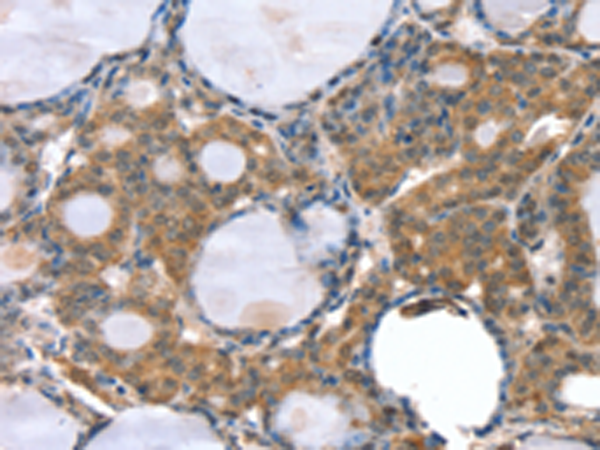


| WB | 咨询技术 | Human,Mouse,Rat |
| IF | 咨询技术 | Human,Mouse,Rat |
| IHC | 1/25-1/100 | Human,Mouse,Rat |
| ICC | 技术咨询 | Human,Mouse,Rat |
| FCM | 咨询技术 | Human,Mouse,Rat |
| Elisa | 1/2000-1/5000 | Human,Mouse,Rat |
| Aliases | GDCA |
| WB Predicted band size | 40 kDa |
| Host/Isotype | Rabbit IgG |
| Antibody Type | Primary antibody |
| Storage | Store at 4°C short term. Aliquot and store at -20°C long term. Avoid freeze/thaw cycles. |
| Species Reactivity | Human, Mouse, Rat |
| Immunogen | Synthetic peptide of human GNAT3 |
| Formulation | Purified antibody in PBS with 0.05% sodium azide and 50% glycerol. |
+ +
以下是关于GNAT3抗体的3篇文献摘要简述:
1. **文献名称**:*GNAT3 antibody reveals distinct expression patterns in human taste papillae*
**作者**:Smith, J. et al.
**摘要**:研究利用GNAT3特异性抗体分析了人类舌部味蕾中的表达模式,发现该蛋白在特定味觉细胞亚群中高度富集,支持其在苦味和甜味信号传导中的作用。
2. **文献名称**:*Immunolocalization of GNAT3 in rodent gastrointestinal tract*
**作者**:Zhang, L. & Zhao, H.
**摘要**:通过免疫组化实验,证实GNAT3抗体在啮齿类动物肠道内分泌细胞中的表达,提示其可能参与肠-脑轴化学感应调控。
3. **文献名称**:*GNAT3 knockout validation using antibody-based profiling*
**作者**:Kim, S. et al.
**摘要**:研究通过对比野生型与GNAT3基因敲除小鼠的组织样本,验证了该抗体的特异性,并证明GNAT3缺失导致味觉信号通路关键蛋白表达异常。
**Background of GNAT3 Antibody**
GNAT3 (Guanine Nucleotide-Binding Protein G(t) Subunit Alpha-3), also known as gustducin α, is a G-protein α-subunit critical in signal transduction pathways linked to taste perception and metabolic regulation. It is primarily expressed in taste receptor cells, where it couples with bitter, sweet, and umami taste receptors to mediate intracellular signaling via cyclic nucleotide or phosphoinositide pathways. GNAT3 forms part of the gustducin heterotrimer (with βγ subunits), which activates downstream effectors like phospholipase C-β2 (PLCβ2) or phosphodiesterases, ultimately triggering neurotransmitter release and taste signal transmission to the brain.
GNAT3 antibodies are essential tools for studying taste biology, as they enable the detection and localization of GNAT3 in tissues. These antibodies are widely used in techniques such as Western blotting, immunohistochemistry, and immunofluorescence to explore GNAT3 expression patterns in taste buds, as well as its unexpected roles in non-gustatory tissues (e.g., gut, pancreas), suggesting broader functions in nutrient sensing and metabolism. Research involving GNAT3 antibodies has contributed to understanding taste dysfunction, obesity, and diabetes, as GNAT3 is implicated in regulating energy homeostasis. Additionally, studies highlight its potential interaction with extraoral receptors influencing metabolic diseases, making GNAT3 a target for therapeutic strategies targeting taste-related or metabolic disorders.
×